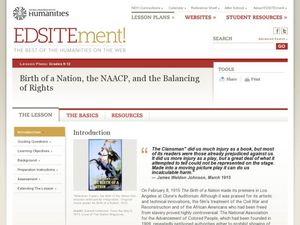Civil War Trust
Uncle Tom's Cabin
Through a careful reading and examination of Harriet Beecher Stowe's Uncle Tom's Cabin, scholars take part in grand conversations about the novel's contents, slavery, and the impact the book had on it. Furthermore, learners analyze an...
Curated OER
Lesson 9: After Slavery: Uncle Tom's Cabin in Popular Culture
Eighth graders, in groups, explore the popularity of Uncle Tom's Cabin, even in the post-slavery America.
PBS
Harriet Beecher Stowe: Author and Abolitionist
Scholars use primary documents, video clips, and legal decisions to uncover Harriet Beecher Stowe's motives for writing Uncle Tom's Cabin. They create a 21st century book jacket for the novel to capture the purpose behind Stowe's story.
Curated OER
Uncle Tom's Cabin
Students analyze the illustrations and cover of the book Uncle Tom's Cabin. In this Uncle Tom's Cabin lesson plan, students discuss the history elements of what they see in the illustrations and cover of the book.
Curated OER
Fugitive Slave Act of 1850
Students take a closer look at the Fugitive Slave Act of 1850. In this slavery lesson, students examine an image and read excerpts from Uncle Tom's Cabin as well as the Fugitive Slave Act of 1850. Students discuss their analysis of the...
Curated OER
Lesson 8: After Slavery: Stowe's Vision
Eighth graders read Uncle Tom's Cabin by Harriet Beecher Stowe.
Curated OER
Determining Author's Point of View: The Sneeches
Determine the author's point of view in a text. Young readers read Dr. Seuss' The Sneeches and identify the author's purpose in the story. They identify persuasive techniques in writing, asking and answering questions to better...
Curated OER
The Kansas-Nebraska Act of 1854: Popular Sovereignty and the Political Polarization over Slavery
Why did Stephen Douglas support the Kansas-Nebraska Act of 1854? Why did Abraham Lincoln oppose it? Young historians examine how the Kansas-Nebraska Act of 1854 affected the political balance between free and slave states and explore how...
Curated OER
Religion in Uncle Tom's Cabin
Students investigate the implications of religious beliefs on the issue of slavery and answer discussion questions.
Curated OER
Uncle Tom's Cabin as Anti-Slavery Argument
Pupils read and discuss how African- Americans are depicted in slave auction announcements. They research how Harriet Beecher Stow responds to the sale of slaves.
Curated OER
Women Characters and Readers
Students participate in a guided reading of Chapter IX in Harriet Beecher Stow's, Uncle Tom's Cabin. They research the topic of gender and present it to the class.
Curated OER
White Southerners' Defense of Slaveholding
Students read transcriptions of articles from two historical Virginian newspapers and examine how white southerners defended the institution of slavery. They write a one-act play or a dialogue between an abolitionist and a slaveholder.
Curated OER
Birth of a Nation, the NAACP, and the Balancing of Rights
Eleventh graders analyze primary sources. In this US History lesson, 11th graders interpret written information. Students evaluate arguments and draw conclusions. Students develop and defend a position.
Curated OER
Abolishing Slavery
Students explain the goals and methods of the abolitionist movement.
They identify key leaders in the movement. This lesson has adaptations for elementary through high school. Links are provided for resource readings.















